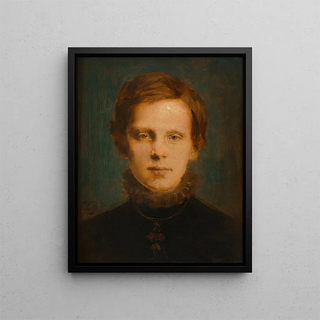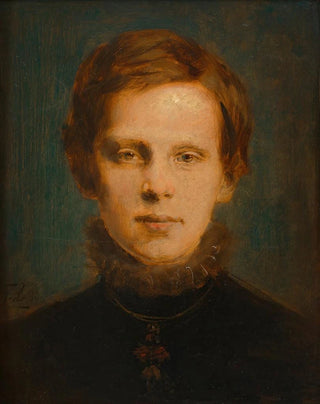Art print Kronprinz Rodolphe - Franz von Lenbach


View from behind

Frame (optional)
Kronprinz Rodolphe Art print - Franz von Lenbach – Captivating introduction
The "Kronprinz Rodolphe" art print by Franz von Lenbach is an iconic piece that embodies the elegance and opulence of the Austrian court in the 19th century. This striking portrait of Crown Prince Rodolphe, son of Emperor Franz Joseph, not only depicts the stature of a man destined to reign but also evokes the tensions and tragedies that would mark his life. Gazing upon this work, the viewer is transported to a world where art and politics intertwine, revealing the subtleties of a bygone era. The art print of this masterpiece allows for rediscovering this fascinating figure and appreciating Lenbach's undeniable talent.
Style and uniqueness of the work
Lenbach's style is characterized by impressive realism and meticulous attention to detail. In "Kronprinz Rodolphe," the artist manages to capture not only the physical features of the prince but also his inner essence. The play of light and shadow enhances the depth of the gaze, while the rich colors of the clothing testify to the luxury that surrounded Rodolphe's life. The composition is carefully balanced, and each element, from the background to the costume, contributes to creating an atmosphere that is both intimate and majestic. This portrait is not merely a simple representation but becomes a true window into the soul of a young man caught in the tumult of his responsibilities and desires.
The artist and his influence
Franz von Lenbach, born in 1836, is one of the most renowned portraitists of his time. His career is marked by encounters with emblematic figures of European art and culture, shaping his unique style. Lenbach succeeded in establishing himself through his ability to convey the psychology of his subjects, and his work influenced many artists of his era. By painting influential personalities, he helped immortalize historical figures while revealing the social dynamics of his time. His technique, combining precision and expressiveness, paved the way for a new approach to portraiture, where emotion and personality take precedence over mere physical representation.

Matte finish

View from behind

Frame (optional)
Kronprinz Rodolphe Art print - Franz von Lenbach – Captivating introduction
The "Kronprinz Rodolphe" art print by Franz von Lenbach is an iconic piece that embodies the elegance and opulence of the Austrian court in the 19th century. This striking portrait of Crown Prince Rodolphe, son of Emperor Franz Joseph, not only depicts the stature of a man destined to reign but also evokes the tensions and tragedies that would mark his life. Gazing upon this work, the viewer is transported to a world where art and politics intertwine, revealing the subtleties of a bygone era. The art print of this masterpiece allows for rediscovering this fascinating figure and appreciating Lenbach's undeniable talent.
Style and uniqueness of the work
Lenbach's style is characterized by impressive realism and meticulous attention to detail. In "Kronprinz Rodolphe," the artist manages to capture not only the physical features of the prince but also his inner essence. The play of light and shadow enhances the depth of the gaze, while the rich colors of the clothing testify to the luxury that surrounded Rodolphe's life. The composition is carefully balanced, and each element, from the background to the costume, contributes to creating an atmosphere that is both intimate and majestic. This portrait is not merely a simple representation but becomes a true window into the soul of a young man caught in the tumult of his responsibilities and desires.
The artist and his influence
Franz von Lenbach, born in 1836, is one of the most renowned portraitists of his time. His career is marked by encounters with emblematic figures of European art and culture, shaping his unique style. Lenbach succeeded in establishing himself through his ability to convey the psychology of his subjects, and his work influenced many artists of his era. By painting influential personalities, he helped immortalize historical figures while revealing the social dynamics of his time. His technique, combining precision and expressiveness, paved the way for a new approach to portraiture, where emotion and personality take precedence over mere physical representation.
12,34 €






